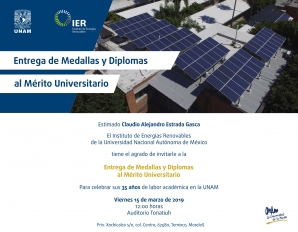Mostrando artículos por etiqueta: PSTFAR publication
Optimal performance assessment for a photo-Fenton degradation pilot plant driven by solar energy using artificial neural networks
A. Bassam, I. Salgado-Tránsito, I. Oller, E. Santoyo, A.E. Jiménez, J.A. Hernandez and A. Zapata.
Abstract
Artificial neural networks (ANN) were proposed as a multivariate experimental design tool for monitoring a photo-Fenton treatment of wastewaters containing a synthetic mixture of pesticides. ANN and Nelder-Mead simplex methods were used to find out the optimum operating parameters of a photo-Fenton pilot plant. ANN was developed to predict the most important operating parameters (e.g., the total organic carbon and the initial mineralization kinetic rate constants of the reactions), which determine the photo-catalytic degradation efficiency in photo-Fenton processes. Experimental measurements of temperature, pH, hydrogen peroxide (H2O2) consumption, initial concentration of Fe2+, and the AE were used as input data for the ANN learning. A feed-forward with one hidden layer, a Levenberg–Marquardt learning algorithm, a hyperbolic tangent sigmoidal transfer function and a linear transfer function were used to develop the ANN model. The best fitting of the training database was obtained with an ANN architecture constituted by seven neurons in the hidden layer. The simulated results were validated with experimental measurements, showing an acceptable agreement (R2 > 0.99). The ANN was subsequently coupled with a Nelder–Mead simplex method to obtain the optimum operating parameters of the photo-Fenton pilot plant. The H2O2 consumption was used as key variable for evaluating the optimization procedure. Errors less than 1% between simulated and experimental data were found. The obtained results showed that the use of ANN provides an excellent predictive performance tool with the additional capability to assess the influence of each operating parameter on the removal process of water pollutants.
Enhanced mineralization of atrazine by means of photodegradationprocesses using solar energy at pilot plant scale
Carlos Antonio Pineda Arellano, A. Jiménez González, Susana Silva Martínez, Iván Salgado-Tránsito, Cesar Pérez Franco
Abstract
Atrazine is a highly persistent and carcinogenic compound used as herbicide around the world. This compound has been banned in USA and some European countries but in Mexico it is still widely used in the agriculture. In order to achieve a high mineralization of atrazine, present as active compound in the Gesaprim commercial herbicide, detoxification studies in two-compound parabolic solar reactors by means of photo-Fenton process followed by TiO2 photocatalysis was carried out. The atrazine contents in the Gesaprim solutions tested were 35 mg L−1 (19.0 mg L−1 of TOC) and 20 mg L−1 (9.5 mg L−1 of TOC). [H2O2]0/COD0 ratios of 1, 3 and 5 (1.5 × 10−3, 4.5 × 10−3 and 7.5 × 10−3 mol L−1 H2O2, respectively) were evaluated in combination with 5 mg L−1 and 10 mg L−1 Fe2+ at pH 2.8 in the photo-Fenton oxidation; whereas, in the photocatalytic process, the influence of the pH (4.8, 7.0 and 11.0) and type of TiO2 (Degussa P25 and HB) were studied with TiO2 content of 200 mg L−1. The study showed that photo-Fenton process followed by TiO2 photocatalysis produce a 72% of mineralization (for an initial TOC of 19 mg L−1) and decrease above 90% of toxicity in compliance with NMX-AA-110-1995-SCFI1 Mexican Norm. In order to established a minimum amount of chemical reagents these photodegradation processes were carried out with special emphasis on the optimization of experimental parameters such as concentrations of photocatalyst and oxidant. Atrazine mineralization was influenced by the pH of the solution, the initial concentration of hydrogen peroxide and iron ions.

